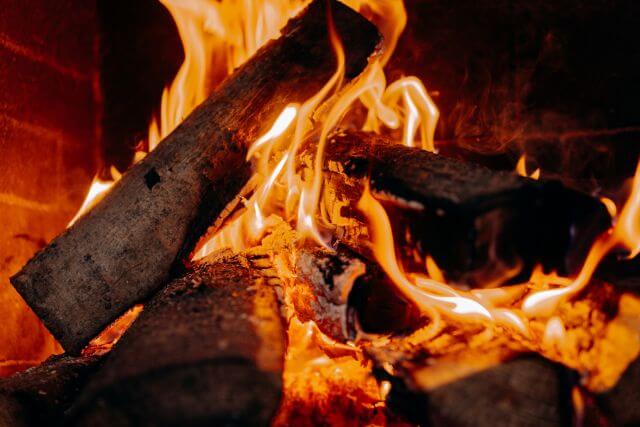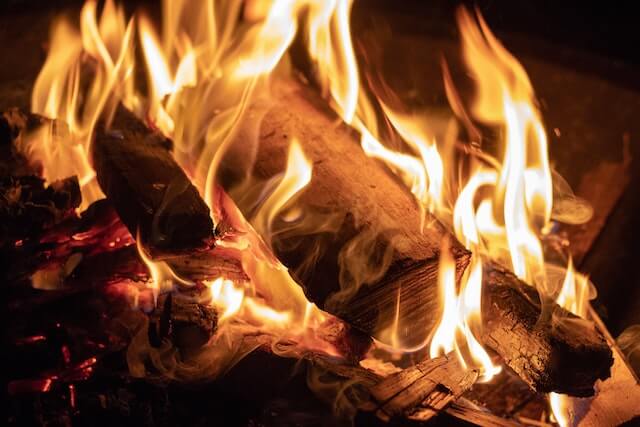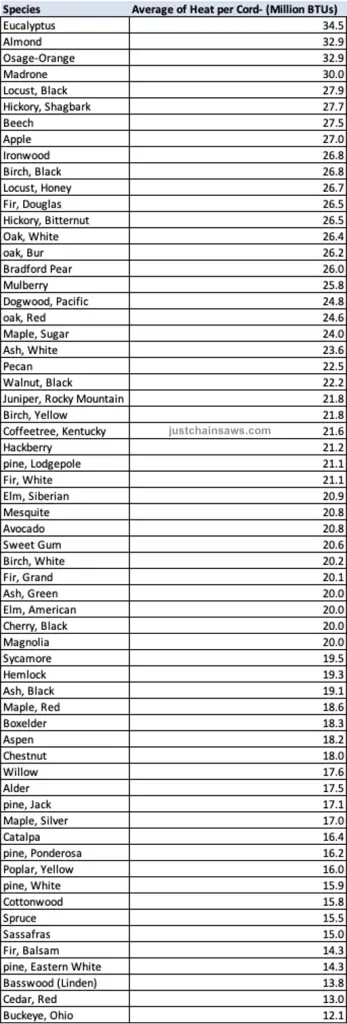Firewood BTUs are a measure of how much energy any given firewood fuel has. For those who burn it, the purpose is obvious – to warm up their living space and make it as cozy as possible.

So choosing firewood that has a higher BTU rating is essential for the efficient burning of wood.
It helps to make sure that your home stays warm while using as little fuel as possible.
The British Thermal Unit (BTU) is basically described as the energy required to raise the temperature level of one pound of water by 1°F.
When temperatures plummet to alarmingly cold levels during the winter, BTUs are the measure of how much heat is required to keep a home warm.
The BTU rating of different types of wood can vary greatly, but there are some general trends. Hardwoods, such as oak and maple, typically have a higher BTU rating than softwoods like pine or spruce. The density of the wood also affects the BTU rating, with denser wood having a higher BTU rating.
The chart below provides an overview of average BTU ratings for different types of firewood. Note that this varies depending on species, moisture levels, and other factors.

Season Your Firewood for Maximum BTU Output:
To maximize the BTU output of your firewood, it is important to use properly seasoned firewood. Seasoning is a process where wood is dried or cured over time. This helps remove moisture from the wood, which increases its combustibility and overall BTU rating.
Unseasoned wood contains too much moisture which makes it difficult to burn.
After cutting down and splitting your logs, leave them in a dry place like a patio or shed to season.

You should ideally wait at least six months before attempting to burn freshly cut wood, as this will give the wood enough time to reach its optimal BTU rating.
By following these steps, you can get the most out of your firewood and ensure that your home stays warm all winter long.
The chart above can provide a good starting point when choosing firewood, but always remember to season it prior to burning.
How Can You Tell When Firewood is Ready?
The best way to tell when firewood is ready for burning is by measuring its moisture content. A good rule of thumb is if its moisture content is below 20%, then it’s ready for use.
To measure the moisture content, you will need a tool called a moisture meter which measures the water content in wood chips or small pieces of wood with electrical current resistance.
Alternatively, you can also test if your wood will burn by taking two pieces and banging them together. If you hear a hollow sound, then the firewood is dry enough to burn.
Benefits of Using Seasoned Firewood
Using seasoned firewood has many benefits, including:
- Increased BTU rating
- Cleaner and more efficient burning
- Less smoke, ash, and creosote buildup in your chimney
- Better overall heating value for your home
- Reduced risk of fire hazards
- Better control of combustion temperatures, resulting in less air pollution.
Seasoned firewood also burns cleaner than other fuels so you don’t have to worry about fumes or hazardous emissions. The firewood is also much easier to split, stack, and store than freshly cut wood, so it can also save you time and energy.
Measuring Your Firewood
Learning to properly measure your firewood is essential for getting the most out of your wood-burning experience.
A cord of firewood is the standard for such measurements and contains 128 cubic feet of wood. To create this volume, the wood is cut into sixteen-inch lengths and arranged in three rows that are stacked four feet tall and eight feet long.

The wood is then tightly stacked to minimize air pockets and the total volume of wood. This measurement ensures each cord has enough wood for winter fires and helps keep costs at a minimum.
Different areas refer to firewood measurements differently. One popular measurement term is the rick or face cord, which consists of a row of 4 feet high and 8 feet long.
The firewood lengths can vary, however, resulting in overall differences in total cubic feet. For example, a rick of 16-inch long firewood will contain one-third of a cord, while the same amount of 12-inch firewood pieces would equal half a full cord.
Firewood BTU Table
Now that we know how seasoned firewood, significantly increases the BTU rating of firewood. Below is a table of the most common types of firewood and their BTU ratings per cord:

Not every firewood option on the table above will be available in all areas, but the table is a good starting point for selecting firewood. If possible, always try to select the highest BTU rating within your budget.
When ordering firewood, it’s also good practice to order more than you think you will need so that you have enough wood over the winter. The extra wood can also be used for next year’s fires.
Hardwoods are a good choice to start with because they tend to have higher BTU ratings than softwoods.
Softwoods on the other hand will be cheaper to buy but will not last as long in the fire.
Conclusion
Choosing the right firewood is essential for creating efficient and safe fires that will keep your home warm all winter long. Firewood with a high BTU rating will produce more heat, making your home warmer and safer.
I personally don’t get too caught up in the BTU ratings as I only have access to Maple wood and Douglas Fir around me, but I always make sure to get the wood seasoned properly before burning.
Make sure to use a moisture meter or test the firewood yourself to ensure it has a moisture content of below 20%, then you can be assured that your fire will burn with maximum efficiency and heat output.
Remember, whatever type of firewood you choose to burn, the most important thing is that it is seasoned and ready for use.
Learn the different wood BTU ratings, moisture content, and measurements, you can get the most out of your firewood and ensure a cozy winter season.
